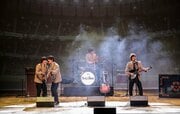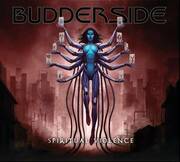New York, NY (Top40 Charts) Composer Caroline Shaw's new album, Narrow Sea, featuring Sō Percussion, Dawn Upshaw, and Gilbert Kalish's performance of the title piece - five parts, each a new setting of a text from The Sacred Harp, the 19th-century collection of shape-note hymns - is due next Friday, January 22, on Nonesuch. Here, the artists talk with writer Matthew Guerrieri about the album, which also includes Sō Percussion's performance of Shaw's Taxidermy.
The old hymn is nonchalant. "I'm only going over Jordan," the wayfaring stranger sings. "I'm only going over home." Still, the Jordan River—the Narrow Sea of Caroline Shaw's cycle for soprano, piano, and percussion, the centerpiece of this new recording—is a profound and protean partition. Narrow Sea was most immediately and explicitly intended and dedicated as a response to and a reflection on a very twenty-first century crisis, that of refugees. (The United Nations estimates that, in 2017, the year Narrow Sea was premiered. some sixteen million people worldwide were displaced from their homes—over 44,000 people per day.) The words offer one level of commentary, confirming the piece as music of transport, traveling music, in the most fundamental sense. The fluidity of the music—individual lines fading in and out of coordination, phrases and proportions in slight but constant flux from performance to performance—creates its own, subtle sense of dislocation. (Even the instrumentation bears a nomadic touch, with two of the percussionists playing set-ups that emulate the compact, pragmatic suitcase kits of itinerant drummers.)
But the Jordan river has borne a whole host of symbolisms, representing the boundary between earthly damnation and divine salvation, between suffering and solace, between bondage and freedom, and, in its most compelling role, between life and death, between this existence and the mystery of what, if anything, lies beyond. As such, Narrow Sea also echoes Shaw's earlier work By and By, which similarly channeled early American hymnody's preoccupation with transience and impermanence. "I was telling a friend, half-jokingly, that, in a lot of my music, I'm trying to figure out a way to talk about death and mortality, or think about it," Shaw muses, with a tone of cheerful, matter-of-fact curiosity. "We don't think about these things quite as much as maybe we used to, when we were much closer to it."
Undiscovered countries, journeys of faith: the work's web of imagery and allusion was reflected in the process of its creation. As with many of her works, Shaw initially offered the performers not a finished score, but a framework and an invitation to flex their expertise. Narrow Sea came about through exploration and iteration. The members of Sō Percussion—Josh Quillen, Adam Sliwinski, Jason Treuting, and Eric Cha-Beach—had worked with Shaw before, and were used to the process. For soprano Dawn Upshaw and pianist Gilbert Kalish, the process was new. "It was fascinating," recalls Kalish. "There was a lot of experimentation during the rehearsal, a lot of trial and error."
Upshaw admits to feeling, at the outset, on uncertain ground—a fear of "not being enough in the situation," as she puts it. But "around the time that we were sort of three-quarters of the way there, I suddenly felt this 'aha' moment where I totally trusted and understood what this was going to be." By the end, Kalish was equally convinced. "I was smitten with this," he says. "It's just very beautiful."
Shaw approached the project with her own trepidation. "I'll just be honest," she says. "I was really intimidated by writing for Dawn and Gil." The rehearsal process was her chance to become familiar with them as musicians, and a chance for their experience and personalities to leave a mark on the piece. "The way that Gil plays the line in movement four is very much him. The way that Dawn sings, the way she paces that out, is very much her." The collaborative aspect is integral to the music. "I'd love to live in a world where my name is not the only name as the composer of this piece, and to be really clear with everyone that, to some extent, the details are a group effort," she says. "The form and the concept are mine and the harmonies are mine and the melody is mine…. But the details, I leave up to them as much as I can." It's an unusual attitude, perhaps, in the sphere of classical-music performance, where, for so long, the primacy of the score has reigned. But, for Shaw, it's simply a head start on how a score should make its way in the world, being adopted and interpreted by any number of performers. "They take it on and take it into their own world and make it their own. And I'm always supportive of that. I think that that's how music should be."
Common to both Narrow Sea and Taxidermy, the 2012 percussion quartet that fills out the recording, is Shaw's fascination with the use of flowerpots as instruments; the unorthodox sound features in both works. Sō Percussion's Cha-Beach remembers that, when the group taught a seminar on the use of found sounds at Princeton, Shaw—then a student—was fascinated with the possibilities. "In some ways, Taxidermy grew out of those experiments: what does it sound like to hit flowerpots with different materials? Different ways of hitting them together? Making grooves with them?" For the group, founded on the ideal of John Cage's expansive notions of musical sound, it was a perfect fit. "Our method with Caroline is just this constant searching for possibilities," Cha-Beach says. "She's got such a great ear and such a great instinct for what sounds good."
It's a small irony that the result of that first encounter was a musical tribute to a bumpier kind of encounter, a vestige of which is preserved in the title. Shaw remembers asking the players to imagine "if you were on a first date with someone and then they said, So I hear you're into taxidermy, and then there's an awkward pause… the deer-in-the-headlights look of that moment—how do you make that in music?" Shaw was also musing on the absurdities that lurk at the core of the classical tradition. "Is classical music a kind of taxidermy? We've sort of stuffed this music and held it and frozen it in time." And so the sound of flower pots wends its way around vibraphone and marimba parts filled with parallel fifths, the most infamous transgression of academic counterpoint. Eventually, the players fall into an obsessive, spoken deconstruction of an elusive phrase: the detail of the pattern is movement.
Taxidermy's repartee seems to inhabit another world from Narrow Sea's dream-like eschatology. But that spoken phrase, one of Shaw's favorites, reveals the pieces to be not quite so far apart. It comes from T. S. Eliot's "Four Quartets":
The detail of the pattern is movement,
As in the figure of the ten stairs
The "ten stairs" are from St. John of the Cross's The Dark Night of the Soul, in which he describes "the mystic ladder of
Divine love" that ends with the soul beyond earthly existence, beyond even purgatory, yet still striving to rise "above all things and above itself." In ways large and small, momentous and mischievous, the music collected here is always going home.























